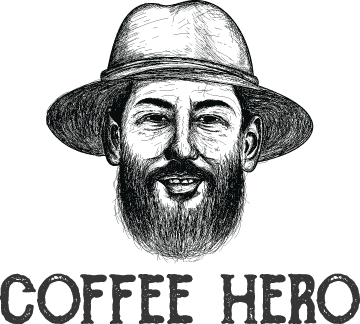
WHAT IS THIRD-WAVE COFFEE?
WHAT IS THIRD-WAVE COFFEE?

Different coffee trends have come and go in the last centuries, but in the last few decades, there has been growth in what we all call the coffee industry. That is third-wave coffee. Most people have not heard about third-wave coffee, people that have heard it are even puzzled. It has become a topic for debate. We are going to tell you all about it, this overview will explain the different waves. These waves/eras have a lot to do with the quality of the beans., how it is sourced and other factors.
As you learn about them, you’ll see the evolution and where it is currently headed. You’ll also know how to communicate to a coffee roaster or a barista about the quality of coffee you want. Let's get to it.
FIRST WAVE COFFEE
The first wave of coffee is considered the wave that produced lowest quality coffee. To date, it is seen as a commodity coffee. Most of the brands that produced first-wave coffee were not focused on sourcing transparency.
Third-wave coffee mostly looked like it came from an industry and not grown on a farm. The brands never got to mention the origin of the coffees or the farm where it came from or the processing methods, One of the characteristics of the first wave coffee was that it was mostly dark roasted and referred to as the pioneer coffee.
The coming of first wave coffee sparked the discovery in coffee farming, distribution, and some other tools we still use today. For example, the coffee distributors made sure that the coffee was packaged properly after they understood that coffee shouldn't be exposed as it may lose its freshness. The brands that sold coffee in this era were more interested in the caffeine kick the drink gave.
It was the same thing with the consumers, they had no idea about the origins or whether the coffee had flavors and aromatic compounds. So that is why instant coffee thrived more in this era. It was mostly made with Robusta coffee beans, hence the bitterness.
It was around this period that the first coffee maker was produced, it revolutionized the way Americans made coffee. By producing a machine that could help coffee drinkers brew coffee efficiently, the modern coffee culture began to emerge.
Third Wave Coffee In a Glance
- The beans were artificially flavored,
- They mostly used the words ‘premium’ or gourmet.
- The coffee was dark and bitter.
- It could always be found in the supermarket aisle.
SECOND WAVE COFFEE
The rise of second-wave coffee is mostly attributed to Starbucks, they revolutionized the coffee culture in many regions. These coffee roasters were able to bring a new life to the coffee industry around the 1900s, they were able to introduce coffee drinkers to a wide variety of coffee.
After seeing what the brands in the first wave era did, they started publishing the regions where they source their coffee, they began to explore coffees with higher quality. As we mentioned, they changed the coffee drinking experience by adding the espresso to sweeteners and other flavored syrups, but they didn't change the coffee itself.
The dark roasting style that produced bitter coffee had not changed. The baristas produced coffees like the cappuccino and lattes which are very common now. The addition of these syrups, whole milk, and whipped cream, made customers frequent the coffee shops and that was okay for the baristas, they were no longer passionate about the beans anymore.
Second Wave Coffee At A Glance
- They focused more on flavored coffee drinks.
- The coffee was still bitter.
- The coffee beans still sat on the supermarket aisle.
- The baristas were more passionate about their café than the coffee beans themselves.
THIRD WAVE COFFEE
The third wave of coffee became popular after a niche community started focusing on the quality of the beans. These small groups of coffee roasters started focusing more on lighter roasts. That is how the Specialty Coffee Association of America came into existence in 1982. After a while, the association started becoming prevalent in other parts of the world like Canada and Australia.
This small group began to grow over the years. In 1999, they coined the term ‘third wave coffee’ and it has become a popular trend up to date.
Now, a coffee renaissance has occurred because customers and home brewers now know that there is more to coffee drinks than the bitterness or woody flavors. Today, the phrase ‘third wave' is mostly interchanged with specialty coffee.
We now have our industry, different trade shows, and even competitions where we won. We are not only passionate about the brewing experience but about the coffee itself. We are transparent when it comes to coffee beans origin and the processing methods, we even source the coffee directly from the farmers.
Third Wave Coffee At A Glance
- There are more specific flavor notes (like chocolatey, fruity, floral, and more).
- Lighter roast
- Single-origin beans
- There is origin transparency.
- Different brewing methods like pour-over and French press.
- Publishing of roast dates and expiry dates on coffee bags.
WHAT MAKES THIRD-WAVE COFFEE DIFFERENT?
We’ll love to explain more about what makes third-wave coffee stand out. Third-wave coffee ensures that the brewer experiences culinary appreciation after drinking the coffee. This means that the consumer will be able to appreciate the subtle flavors, know the type of coffee beans (Arabica or Robusta) and different varieties, growing regions (high or low elevation).
Also, because of third-wave coffee, the beans are sourced from the farmers and roasted properly to bring out the unique characteristics of each coffee bean. This will ensure that every flavor you taste is pure and clean.
TECHNIQUES OF THIRD-WAVE COFFEE ROASTERS
Third-wave coffee roasters are more focused on producing lighter or medium-dark roast instead of just roasting the coffee till it gets burnt. Third-wave roasters encourage coffee drinkers to try different brewing methods that will bring out the best flavors from their coffee beans. Some of these brewers include portable espresso makers, Aeropress, siphon, etc. (you may have one of these in your kitchen).
Baristas in this era are producing sweeter and thicker espresso that some coffee enthusiasts can't stop talking about. These are mostly double ristretto (this means that they use 20 grams of espresso for every shot instead of the normal one that is about 9 grams).
As we previously mentioned, specialty coffee can be seen as the third wave coffee movement. The baristas are happy to steam milk that produces the perfect microfoam, and it blends well with coffee. The third wave is all about making the home brewer or customer feel special. The customers not only get to enjoy a great cup of coffee, but they also learn the story behind the cup.
THIRD-WAVE COFFEE IN AUSTRALIA
The Australian specialty coffee scene is thriving. It has paved the way for third-wave coffee. The phrase 'third wave coffee’ is not mentioned here, what you’ll mostly hear is ‘specialty coffee’. Australian roasters now roast lighter and import coffee from other regions and mention the origin and the roasting process as they market the coffee.
We must say that the third wave movement hit our shores and the practices are still common here. Our roasting and brewing methods meet the Specialty world standard. It is just the name ‘third wave coffee’ that didn't stick around here.
WHAT'S NEXT?
As the coffee industry continues to thrive in our world, some coffee experts predict the fourth wave. Is it for sure? We don't know, but it looks like another phase is fast approaching and it will focus more on the producers and the customers.
Sustainable farming practices will continue and it will have a positive impact on the quality of coffee you drink. But let's watch out, only time will tell us more about the fast-growing coffee industry.
Coffee Hero is among the third-wave roasters, we are careful about the way we roast our coffee. We ensure that they are not burnt and always freshly roasted. To understand what the third wave coffee is about, try our specialty-grade roasted coffee beans.
All you have to do is order it here and it will be delivered to you in a few hours. The rich, bold, and balanced flavors from these beans will make you avoid walking down the aisle of drinking first or second-wave coffee.


